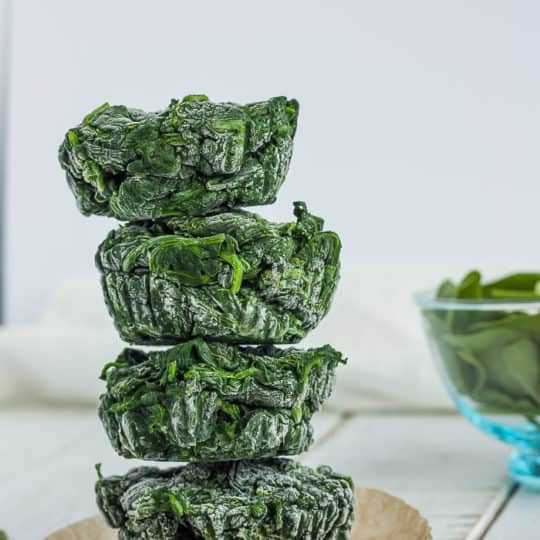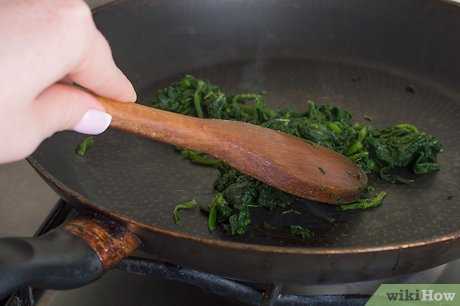Many people wonder if it is possible to cook frozen spinach. The good news is that yes, you can cook frozen spinach. In fact, cooking frozen spinach is very easy and convenient. It can be a great addition to many dishes, providing a healthy and nutritious alternative to fresh spinach.
When cooking frozen spinach, it is important to follow a few simple steps. First, thaw the spinach by either microwaving it or letting it sit out at room temperature. Once thawed, squeeze out any excess water from the spinach. This will prevent your dish from becoming watery.
There are many delicious recipes that you can make using frozen spinach. You can use it in pasta dishes, soups, casseroles, or even as a side dish. Adding frozen spinach to your meals is a great way to increase your vegetable intake and enjoy the benefits of this nutritious green leafy vegetable. So next time you are looking for a quick and easy way to incorporate spinach into your meal, consider using frozen spinach.
In conclusion, cooking frozen spinach is not only possible, but also very convenient. Whether you are a busy parent or a professional with limited time, frozen spinach can be a healthy and easy way to add some green to your meal. So go ahead and give it a try – you might be surprised at how delicious and versatile frozen spinach can be!
Is it possible to cook frozen spinach?

Yes, it is possible to cook frozen spinach. The process is fairly straightforward and can result in a delicious and nutritious meal. Frozen spinach is a convenient option as it is already cleaned, chopped, and blanched, saving you time and effort. There are several methods you can use to cook frozen spinach, including steaming, sautéing, or adding it directly to soups and stews.
Steaming
Steaming is a popular and healthy way to cook frozen spinach. To steam frozen spinach, simply place it in a steamer basket over boiling water. Cover the pot and let the spinach steam for 5-7 minutes, or until it is heated through and tender. Once cooked, you can season the spinach with your choice of spices, herbs, or a splash of lemon juice.
Sautéing
Sautéing frozen spinach is another quick and easy method. Start by heating a tablespoon of oil or butter in a skillet over medium heat. Add the frozen spinach and cook, stirring occasionally, until it is heated through and any excess moisture has evaporated. This usually takes about 5-7 minutes. For extra flavor, you can add minced garlic or onions to the skillet before adding the spinach.
Tip: If the spinach releases a lot of moisture during cooking, you can drain any excess liquid before serving.
Using frozen spinach in soups and stews is also a convenient option. Simply add the frozen spinach directly to the pot and let it cook along with the other ingredients. The heat from the cooking process will thaw and cook the spinach, infusing your dish with its tasty flavor and nutrients.
| Pros | Cons |
|---|---|
| Convenience – frozen spinach is already cleaned, chopped, and blanched | It may lose some of its crispness and texture during freezing and thawing |
| Versatility – can be used in a variety of dishes such as stir-fries, omelettes, and quiches | It can be more expensive than fresh spinach |
| Nutrition – retains most of the nutrients found in fresh spinach | May have a slightly different taste and appearance compared to fresh spinach |
In conclusion, cooking frozen spinach is not only possible but also a convenient way to add greens to your meals. Whether you choose to steam, sauté, or use it in soups and stews, frozen spinach can be a versatile and nutritious ingredient in your cooking.
What is frozen spinach?
Frozen spinach is a convenient and versatile option for including leafy greens in your meals. Spinach is known for its numerous health benefits and is a great source of vitamins and minerals. Frozen spinach is produced by harvesting fresh spinach leaves and freezing them quickly to preserve their nutritional content.
Benefits of frozen spinach

- Nutritional value: Frozen spinach retains most of its nutritional value, including vitamins A, C, and K, as well as iron and calcium.
- Convenience: Frozen spinach is readily available in grocery stores and can be stored for a longer period compared to fresh spinach.
- Versatility: Frozen spinach can be used in a variety of dishes, including soups, stews, casseroles, and smoothies.
- Cost-effective: Frozen spinach is often more affordable than fresh spinach, making it a budget-friendly option.
- Reduced waste: Using frozen spinach allows you to take only what you need, reducing the risk of wasting fresh spinach leaves.
Overall, frozen spinach is a convenient and nutritious option for adding greens to your meals. Whether you are making a quick and easy stir-fry or a comforting spinach and feta quiche, frozen spinach can be a time-saving ingredient that still packs a nutritional punch.
Benefits of cooking frozen spinach
Cooking frozen spinach can provide several benefits. Frozen spinach is a convenient and versatile option that can be stored longer and used in various recipes. It retains its nutritional value and offers several health benefits. Here are some of the benefits of cooking frozen spinach:
| 1. High in nutrients | Frozen spinach is packed with essential vitamins and minerals, including vitamin K, vitamin A, vitamin C, iron, and calcium. These nutrients are important for maintaining healthy bones, immune function, and optimal overall health. |
| 2. Antioxidant-rich | Spinach is loaded with antioxidants that help protect the body against damage caused by free radicals. Antioxidants can reduce the risk of chronic diseases, such as heart disease and certain types of cancer. |
| 3. Supports digestion | The high fiber content in spinach can promote regular bowel movements and prevent constipation. It also aids in maintaining a healthy digestive system. |
| 4. Weight management | Frozen spinach is low in calories and high in fiber, making it a great choice for weight management. It can help you feel fuller for longer, reducing the risk of overeating. |
| 5. Versatile ingredient | Frozen spinach can be used in a variety of dishes, including soups, stews, casseroles, and smoothies. It adds a nutritious boost to any recipe and enhances the flavor and texture of the dish. |
| 6. Easy to prepare | Cooking frozen spinach is quick and simple. It can be steamed, sautéed, or added directly to recipes without thawing. This makes it a convenient option for busy individuals or those who want a quick and nutritious meal. |
Overall, cooking frozen spinach offers numerous health benefits and is a versatile ingredient that can be incorporated into various recipes. Adding frozen spinach to your diet can help you meet your nutritional needs and support overall well-being.
Cooking methods for frozen spinach
There are several cooking methods you can use to prepare frozen spinach. Whether you want to use it as a side dish or incorporate it into a recipe, these cooking methods will help you make the most of your frozen spinach.
1. Stovetop: To cook frozen spinach on the stovetop, start by heating oil or butter in a pan over medium heat. Add the frozen spinach and cook until heated through, stirring occasionally. This should take approximately 5-7 minutes. You can season it with salt, pepper, and any other desired spices.
2. Microwave: For a quick and convenient cooking method, you can use the microwave. Place the frozen spinach in a microwave-safe dish and cover it with a lid or microwave-safe plastic wrap. Cook on high for 2-3 minutes, or until heated through. Stir the spinach halfway through the cooking time to ensure even heating.
3. Oven: If you prefer a roasted flavor, you can cook frozen spinach in the oven. Preheat your oven to 375°F (190°C). Spread the frozen spinach evenly on a baking sheet and drizzle with olive oil. Bake for 20-25 minutes, stirring occasionally, until the spinach is heated through and slightly crispy. Season with salt, pepper, and other preferred spices.
4. Boiling: Boiling frozen spinach is another simple method. Bring a pot of water to a boil and add the frozen spinach. Cook for 5-8 minutes, or until heated through. Drain the spinach and season with salt, pepper, and any other desired seasonings before serving.
Regardless of the cooking method you choose, remember to always follow the instructions on the packaging for the best results. Frozen spinach can be a versatile and nutritious ingredient to have on hand for a variety of dishes.
Recipes using frozen spinach
Frozen spinach is a versatile ingredient that can be used in a variety of recipes. Whether you’re looking to add some nutrients to your breakfast, lunch, or dinner, frozen spinach can be a great addition to any meal. Here are a few recipes that make use of frozen spinach:
| Recipe | Description |
|---|---|
| Spinach and feta stuffed mushrooms | This recipe combines frozen spinach with feta cheese to create a delicious filling for mushrooms. Simply mix thawed frozen spinach with crumbled feta cheese, garlic, and seasonings. Stuff the mixture into mushroom caps and bake until the mushrooms are tender and the filling is golden brown. |
| Spinach and artichoke dip | Using frozen spinach in this classic dip is a great way to add some green to the dish. Thaw the spinach and squeeze out any excess moisture. Mix the spinach with cream cheese, sour cream, grated Parmesan cheese, and artichoke hearts. Bake until bubbly and serve with tortilla chips or bread. |
| Spinach and feta stuffed chicken breasts | Frozen spinach can add a pop of color and flavor to stuffed chicken breasts. Thaw the spinach and mix it with feta cheese, minced garlic, and seasonings. Cut a pocket in each chicken breast and stuff with the spinach mixture. Bake until the chicken is cooked through and the filling is melted and bubbly. |
| Spinach and chickpea curry | Frozen spinach is a great addition to vegetarian curries, providing a nutritious base and vibrant color. Simply thaw the spinach and add it to a curry sauce made with spices, tomatoes, and chickpeas. Simmer until the flavors meld together and serve with rice or naan bread. |
These are just a few examples of the many recipes that can be made using frozen spinach. Experiment with different combinations and flavors to create your own unique dishes!
Questions and answers
Can you cook frozen spinach?
Yes, you can cook frozen spinach. Frozen spinach is a convenient and nutritious option for cooking. It can be used in a variety of dishes such as stir-fries, soups, casseroles, and pasta dishes.
How do you cook frozen spinach?
To cook frozen spinach, you can either boil it on the stovetop or microwave it. For stovetop cooking, simply place the frozen spinach in a pot of boiling water, cook it for a few minutes until heated through, and then drain. For microwave cooking, place the frozen spinach in a microwave-safe dish, cover it, and cook on high for a few minutes until heated through.
What can you make with frozen spinach?
Frozen spinach can be used in a variety of dishes. You can make spinach and feta stuffed chicken breasts, spinach and artichoke dip, creamy spinach pasta, spinach and mushroom quiche, or even add it to smoothies for a nutritious boost. The possibilities are endless!
Is frozen spinach as healthy as fresh spinach?
Frozen spinach is just as healthy as fresh spinach. The freezing process helps to preserve the nutritional value of the spinach. It is a good source of vitamins, minerals, and antioxidants. It is a convenient option to have on hand when fresh spinach is not available.







